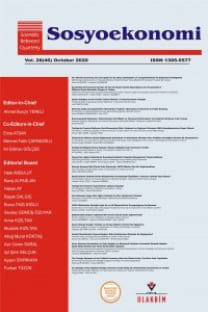Bu çalışmanın amacı il bazında gelir eşitsizli ve iller arasında mekânsal otokorelasyonu, zengin ve fakir illerin dağılımının tesadüfi ya da bir şablon takip edip etmediğini incelemektir. Gini sonuçları incelenen dönem boyunca artış göstermektedir ki bu da gelir eşitsizliğinin artığına işarettir. Gini ile illerin nüfuslarının da dikkate alındığı Ağırlıklı Gini sonuçları kıyaslandığında gelir eşitsizliğinin daha da arttığı görülmektedir. Mekânsal otokorelasyon sonuçları iller arasında kayda değer seviyede otokorelasyon olduğunu ortaya koymaktadır. Fakir (zengin) iller çoğunluklar diğer fakir (zengin) iller ile çevrelenmiştir. Bir diğer önemli sonuç ise, batılı zengin iller ile doğudaki fakir iller arasında çizilebilecek farazi bir sınırın olduğu ve bu sınırın zaman içerisinde daha batıya kaydığıdır. Bu durum ülkedeki zenginliğin zaman içerisinde battı illerinde konsantre olduğu şeklinde yorumlanabilir.
Anahtar Kelimeler:
Bölgesel Gelir Dağılımı, Bölgesel Gelir Eşitsizliği, Bölgesel Gini Endeksi, Mekansal Otokorelasyon
Provincial Income Inequality and Spatial Autocorrelation Across Turkish Provinces: 1992-2013.
The aim of this paper is to investigate provincial income inequality, the degree of spatial autocorrelation between provinces in Turkey and to determine whether low and high income provinces are randomly distributed or not. It may be argued that especially after 1980, the increase in economic integration with the western, developed economies, importance of Turkey as an economic counterpart has increased which ultimately has caused an uneven economic transformation among Turkish provinces. Only some particular sectors, labor force or some particular lifestyles could manage to survive in this progress and unfortunately, during this period, some provinces of Turkey have been kept away from economic growth.Results indicate that both unweighted and weighted Gini coefficients are increasing throughout the period under question, indicating that regional income inequality is increasing over time. Yet, the rate of increase is relatively low. When the difference between the Weighted and Unweighted Gini coefficients are considered, it becomes evident that the level of inequality even further increases when population shares of provinces are taken into consideration. In terms of spatial autocorrelation, results indicate that there is a strong spatial autocorrelation between provinces. Low (high) income provinces are mostly surrounded by low (high) income provinces. This is a proof that there are regional income clusters in Turkey rather than a random distribution of low and high income provinces. Another important conclusion of the spatial autocorrelation analysis is that the tentative border between the high income west and poor income east moves even further west throughout the period under question. This fact may be interpreted as further concentration of richness at the western provinces.
Keywords:
Regional Income Distribution, Regional Income Inequality, Regional Gini Index, Spatial Autocorrelation,
___
- Prof. Dr. Ferda Halıcıoğlu, Medeniyet Üniversitesi İktisat Bölümü, ferda.halicioglu@medeniyet.edu.tr , fhalicioglu@yahoo.co.uk
- Doç. Dr. Vedit İnal, Yeditepe Üniversitesi İktisat Bölümü, vinal@yeditepe.edu.tr, veditinal@yahoo.com
- ISSN: 1305-5577
- Yayın Aralığı: Yılda 4 Sayı
- Başlangıç: 2005
- Yayıncı: Sosyoekonomi Derneği
Sayıdaki Diğer Makaleler
Hayal Ayça ŞİMŞEK, Nevzat ŞİMŞEK
Mahmut ZORTUK, Noyan AYDIN, Semih KARACAN
Ulusal Varlık Fonlarını Anlamak: Fırsat Mı, Tehdit Mi?
Ahmet Burçin YERELİ, İlker YAMAN
Mahmut ZORTUK, Semih KARACAN, Noyan AYDIN
Türkiye’de İBBS 2 Bölgeleri Arasında Gelir Yakınsaması Var Mıdır? Mekânsal Ekonometrik Bir Katkı
Ticari Dışa Açıklık ve Dış Ticaret Hadleri Dış Borçlanma Üzerinde Etkili mi? Türkiye İçin Bir Analiz
